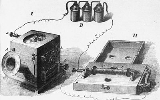
Reis telephone
Encyclopedia

Later developments
In 1862, Reis demonstrated his telephoneTelephone
The telephone , colloquially referred to as a phone, is a telecommunications device that transmits and receives sounds, usually the human voice. Telephones are a point-to-point communication system whose most basic function is to allow two people separated by large distances to talk to each other...
to Wilhelm von Legat, Inspector of the Royal Prussian Telegraph Corps who produced an account of it (Legat, 1862), a translation of which was obtained by Thomas Edison
Thomas Edison
Thomas Alva Edison was an American inventor and businessman. He developed many devices that greatly influenced life around the world, including the phonograph, the motion picture camera, and a long-lasting, practical electric light bulb. In addition, he created the world’s first industrial...
in 1875 and was used in Edison's successful development of the carbon microphone
Carbon microphone
The carbon microphone, also known as a carbon button microphone or a carbon transmitter, is a sound-to-electrical signal transducer consisting of two metal plates separated by granules of carbon. One plate faces outward and acts as a diaphragm...
(the Legat account included drawings that are different from the one below suggesting that it is of a later version). Edison acknowledged his debt to Reis thus:
The first inventor of a telephone was Phillip Reis of Germany only musical not articulating. The first person to publicly exhibit a telephone for transmission of articulate speech was A. G. Bell. The first practical commercial telephone for transmission of articulate speech was invented by myself. Telephones used throughout the world are mine and Bell's. Mine is used for transmitting . Bell's is used for receiving. (Edison 2006, [LB020312 TAEM 83:170])
However Reis' telephone was not limited to musical sounds. Reis also used his telephone (the word also invented by Reis) to transmit his phrase "The horse does not eat cucumber salad". This phrase in German is hard to understand acoustically so Reis used it to prove if speech can be recognized on another side successfully.
Loudspeaker
Reis's speaker worked by magnetostrictionMagnetostriction
Magnetostriction is a property of ferromagnetic materials that causes them to change their shape or dimensions during the process of magnetization. The variation of material's magnetization due to the applied magnetic field changes the magnetostrictive strain until reaching its saturation value, λ...
. In his first receiver he wound a coil of wire around an iron knitting needle and rested the needle against the "F" hole of a violin. As current passed through the needle, the iron shrank and a click was formed. The image shown below is a more advanced version where the iron bar is clamped to a cigar-box-shaped resonator
Resonator
A resonator is a device or system that exhibits resonance or resonant behavior, that is, it naturally oscillates at some frequencies, called its resonant frequencies, with greater amplitude than at others. The oscillations in a resonator can be either electromagnetic or mechanical...
. This receiver is very insensitive. It produces weak sound but has good fidelity
Fidelity
"Fidelity" is the quality of being faithful or loyal. Its original meaning regarded duty to a lord or a king, in a broader sense than the related concept of fealty. Both derive from the Latin word fidēlis, meaning "faithful or loyal"....
. It requires very high current and is a current-sensitive device rather than a voltage
Voltage
Voltage, otherwise known as electrical potential difference or electric tension is the difference in electric potential between two points — or the difference in electric potential energy per unit charge between two points...
-sensitive device.
Reis was marginally successful. This instrument could transmit continuous musical tones but produced indistinct speech. In 1865, however, Britsh scientist David E. Hughes
David E. Hughes
David Edward Hughes , was a British scientist and musician. Hughes was co-inventor of the microphone, a harpist and a professor of music.-Biography:...
used Reis' telephone with "good results" .

See also
- TelephoneTelephoneThe telephone , colloquially referred to as a phone, is a telecommunications device that transmits and receives sounds, usually the human voice. Telephones are a point-to-point communication system whose most basic function is to allow two people separated by large distances to talk to each other...
- History of the telephone
- Invention of the telephoneInvention of the telephoneThe invention of the telephone is the culmination of work done by many individuals, the history of which involves a collection of claims and counterclaims. The development of the modern telephone involved an array of lawsuits founded upon the patent claims of several individuals...
- Timeline of the telephoneTimeline of the telephoneBelow is a timeline of the telephone that covers many important dates in the history of the telephone.- 1844 to 1875 :* 1844: Innocenzo Manzetti first mooted the idea of a “speaking telegraph” ....
External links
- "The Great Telephone Mystery" accessed September 5, 2006
- BBC - Bell 'did not invent telephone' - Dec 1 2003

